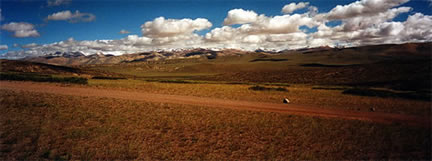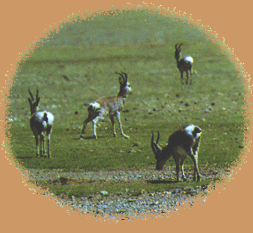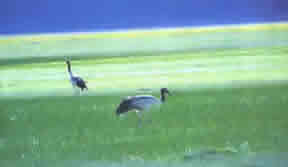| WildLife
of Ngari

The vast plateau of the
western Tibet is known as Jangthang. "Jang" means
north and "thang" means plain. Some parts of Ngari
region are more green than others. This region has many different
species of birds, plants and animals, which are unique and
rare for this part of the world.

Tsoe, a
small antelope, are one of the most endangered species in
Ngari. Tibetans say, Tsoes have the nicest rules in the kingdom.
They migrate from one area to the next. They know how to survive
in the harshest climate in the world. According to the saying,
Toes abandon no one because the leader keeps the herd together.
In last the hundred years,
especially in the 1970s and 1980s, thousand and thousands
of Tsoes were slaughtered to make a type of shawl known as
Pashimina. This shawl business was started somewhere in Kashamire,
north India. They require the finest hair of the Tsoe hide
or skin. To produce a shawl they need between five to seven
hides or skins. These shawls are sold all over the world.
Poachers show no mercy
for these animals. To kill the animals, poachers use machine
guns, mental and traditional Toes' horn traps. They even run
down the Tsoes with high speed trucks. Poacher watch the herd
all day long. Some people say, Toes are stupid animals. Because
at night, Toes run into the head lights of trucks. Poachers
kill as many Tsoes as they can, take off the skins, leave
everything else behind. If poachers can kill the leader, they
can around up the whole herd. Without a leader, Tsoes don't
know where to run.

Kyang
is Tibetan term for wild asses. They usually stay in a herd
up to 80 and grass leisurely on grasses. First, when they
come across a human, they immediately dash away. After galloping
for a while, they stop if they see no danger. Then, they may
show great curiosity about what you are doing.
Elder Tibetans say that
some Kyang are the riding horses of Sadeg (the spirit landowners)
and Lha (deities"). These Kyangs stay alone and they
have natural markings that look like saddles on their back.
According to an ancient saying, a Kyang without a long tail
can be very dangerous and even cause death.
Some nomads in Tibet hunt
Kyang and eat their flesh. It is a common use of Kyang hide
to make saddle bags (special bags used on horses) and tail
straps.

Grong
is the Tibetan name for wild yak. A Grong can weigh about
1,000 kilograms and can be twice size of a domestic yak. They
grow long hair of a dark brown colour. Grong are said to be
so strong that they can overturn a truck with their horns.
Normally shy creatures, Grong can only be seen at a distance.

Krung-Krung Kyid-Nag
is Tibetan term for Black-necked cranes. This species
of crane is unique to Tibet. It is listed as an endangered
species. Reports say that there are only 1,000 Black-necked-cranes
surviving in the world. This crane is usually not seen in
Ngari region, but some people claim to have seen them around.

Nyin (wild sheep), Na-Wa
(wild goats), Chang kyi (wolves), Kyi Chang, (wild dogs) A-Mo
(foxes), and \many others are found in Ngari.

|